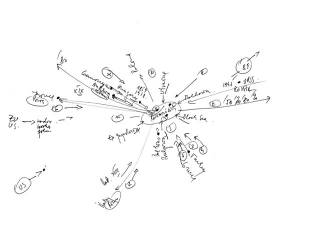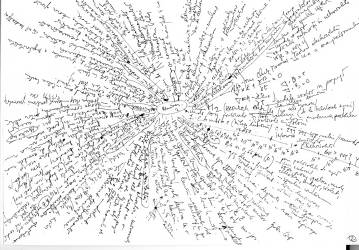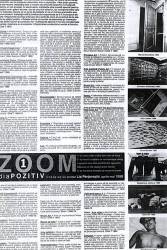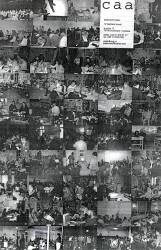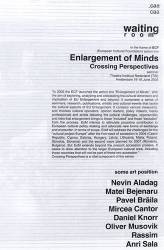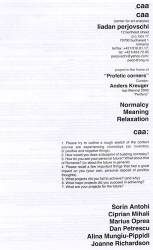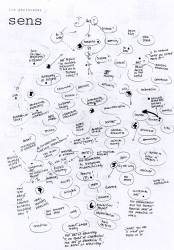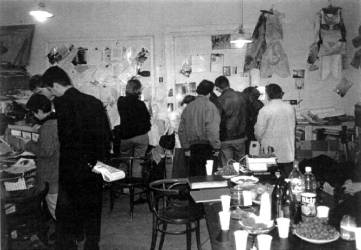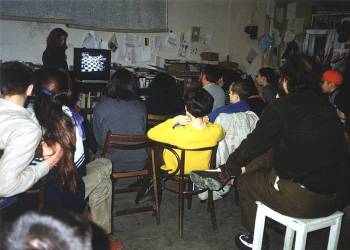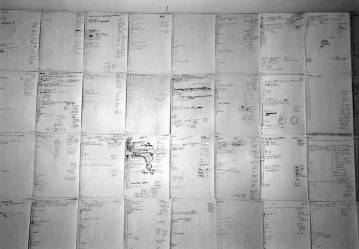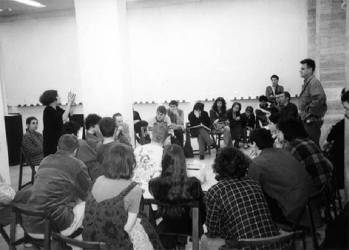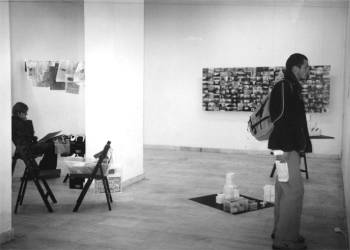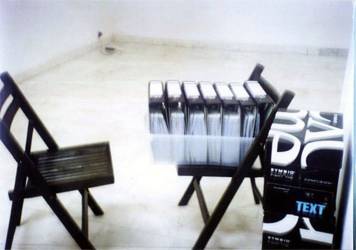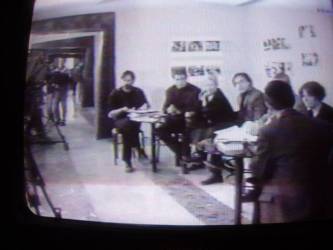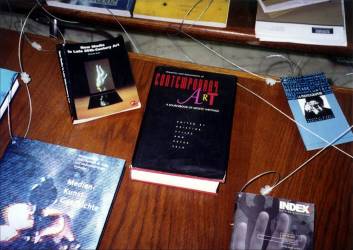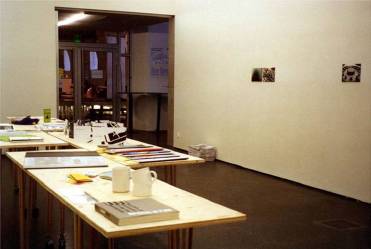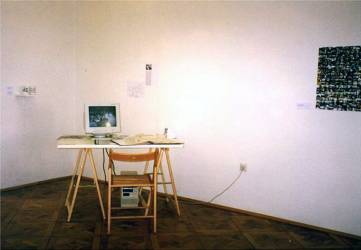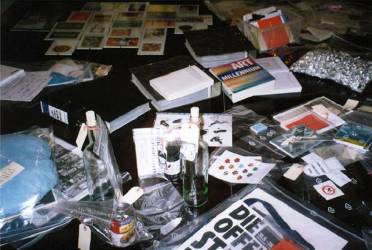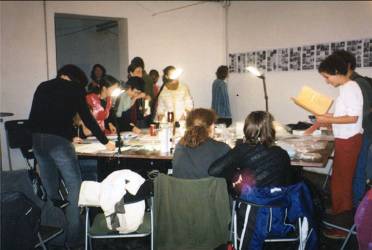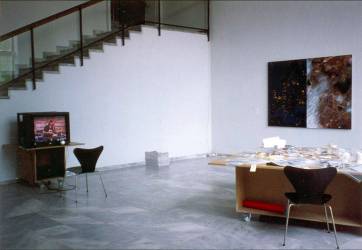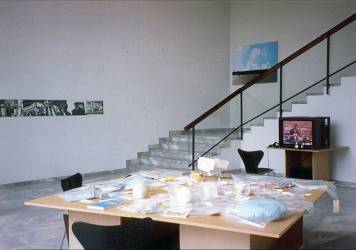| |
|
||||||||||||||||||
| |
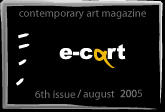 |
 |
|
||||||||||||||||
 |
|
 |
|
||||||||||||||||
 |
|
||||||||||||||||||
 |
|
||||||||||||||||||
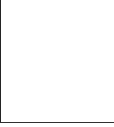 |
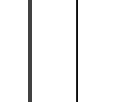 |
 |
|
||||||||||||||||
 |
 |
 |
|
||||||||||||||||
 |
 |
|
|
||||||||||||||||
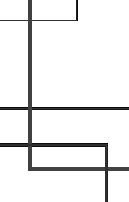 |
|
||||||||||||||||||
| |
 |
|
 |
|
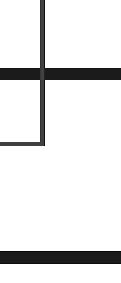 |
|
|
|
|||||||||||
| |
|
||||||||||||||||||
| |
|
||||||||||||||||||
 |
|
||||||||||||||||||
 |
|
||||||||||||||||||
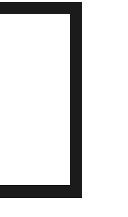 |
|
||||||||||||||||||
 |
|
||||||||||||||||||
 |
|
||||||||||||||||||
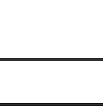 |
|
|
|
||||||||||||||||
 |
|
||||||||||||||||||
| |
|
|
|
|
|
|
|
|
|
|
|
|
|
|
|
|
|
|
|
[From the Contemporary Art Archive to the Centre for Art Analysis]
In fact I never liked I called it an archive; (when I was in Sibiu, in high-school, all the time I was passing by the Archives of the City; it was a beautiful building, which always had a huge lock, and all the time I was wondering, what these archives would contain?; I never thought of going there or to try and research, because I didnít know what to research, but I imagined what it could contain: photographs, documents, lettersÖ - and I think that if you imagine is anyway much better than if you go there. Anyhow, I was associating the archive with dust, with dusty files, inactivated, not manipulated by anyone, and thatís where my restraint to use the word archive came from). Also, I didnít really try hard to find another term, as in a way my material was a research material and an archive structure was suitable for it.
Now I canít give up the word archive, and I donít even want to, as it covers a certain way of working, it was a period (entire years) of archiving and then of research.
How I started this archive: first I wanted to know what is art, art theory, art education, even management, critic, curator, all these notions which I never learnt (in school), and which I was trying to understand.
Everything was organic; I was starting something that necessitated a certain attitude, a certain approach, a certain frame, etc.
After I had my first exhibition with the Archive in the public space, at the gallery Studio 35, in 98, working to structure my material, I started to read it more attentively and to realise that certain paths for analysis were developing, and in this way it is natural to arrive at a centre for art analysis, and to detective; itís not just a simple decision, like what if I was a detective?; I felt like a detective, digging, for example I realised I wonít have enough time to research even the materials that I have, and all their openings; so the archive can be structured in different way, it could be chronologically, a West-East mix, alphabetically, thematically, on mediums, on countries, on subjectsÖ Now it is somehow as a museum, on departments.
In fact itís the system that pushes one to articulate as a project, or as an institution. As for the history of this archive, I pushed†the moment of beginning farther in time, in 85, as it was then when I had an apartment and organized informal meetings, without plan and project, without calling it art, but doing in fact what we do also now: putting into contact people from different fields. In fact I wanted to listen and to find out how the other was working, the theatre director, the actor (the milieu in which we were moving then, in Oradea), and it is apartment art if you want, or relational aesthetics from 85, if we want to name it with a word that now everybody understands. It was an articulation of a professional context within which to move, as otherwise I was moving inside my flat, who wants to realise they are moving inside a flat from a block of flats?!; everything was unclear, and these things helped me to find my place somehow, to find a reference point in the other, to know what they think, and if we can somehow collaborate; these were not events, it happened when we had something to eat, a certain amount of good mood, when we were paid the wages, when the theatre directors from Bucharest came to work on a certain play; I was working at the theatre, Dan at the museum, Dan was visited by journalists, students, fansÖ
In 87 I founded within the Art Academy the experimental studio, for which I had guests from outside the academy; I made performaces, I was answered with other works; everything was connected. After the open flat there was the experimental studio, and in 91 we [Dan and I] received an artist studio; what were we to produce, we didnít have any money, so we invited people that we met, from different fields, plus the wave of Westerners who had started to come to the East. In 96 we opened the studio, pretending it was a sort of space where anyone can come, we didnít arrange anything inside it, we left it as it was, and it went like this for a week, and then the TV and radio came, we had live transmissions from the studio; the end of this was a debate, with people from different disciplines, about the freedom of expressionÖ
I like more to rely on intuition, Iím not pretending I am right, I look for and I find the material that satisfies my questions.
Iím not living in the West, Iím not living here anymore either; here itís a weak context, you cannot possibly rely on it as you would be finished, in the West you are not living long enough to understand it, so in this space between I thing I situate myself, as a person, as a professional, as an approachÖ, a researcher in between, and then itís normal that I can only count on intuition.
In 99 I started to prepare the second presentation in the public space, and thatís when I arrived at the Centre for Art Analysis; about this moment there can be many dates, if someone, another detective, starts questioning me and wants precisely some things, as they can be relevant, the itinerary can be reconstituted point by point.
Another important moment which makes the demonstration of the Centre would be the publication-newspaper Sense, which before it became a newspaper was a diagram of the art context in Romania, published in Balkon [contemporary art magazine in Romania], I think this must have been in 99, and in which I was trying to show the positions in contemporary art at a national level, with official and alternative ones, and this implies a research.
I might as well think of using a 3rd CAA, the Autonomous Art Centre, as there was our money, and it resembles a private collection after all.
I think the Centre sounds more categoric, and more serious, more theoretical, thatís why I think it covers better what I do now.
Detective is a word which was born from several situations, just like dizzydent; dizzydent is connected more to our attitude towards the museum [the National Museum of Contemporary Art in Bucharest], I was talking to Dan about this, and we were joking, but in fact itís real dissidence, with stomach aches, with panic, but also with an attitude where you assume any risk, as the authentic dissidents did in communism; on the other hand, although the tension is powerful, finally the borders are not closed anymore, you have a passport in your pocket and a support abroad, a network which is easier to build.
Detective: I was thinking, if I say researcher, which seemed to me a very interesting character, totally absorbed into his/her discipline, well, Iím not really like that, to make abstraction of everything outside, I have an amazing patience and projects developed in years, but I have contact with the outside, Iím not really autistic, and thus the story with the detective is more appropriate, as you have a thread and youíre following it, now I donít know if itís about a corpse, an intellectual theft, of kidnapped people or all of these together. †
† † [How do you see the public of the archive, the people who came to your studio and participated in a way or another to the CAA]
You know we did performance; I believe we did it for real, we invented it for ourselves in 87, when we didnít know what performance was. So this idea to release anything in this communication with the other which is the so-called public, goes back to the beginning of the Archive; I always liked the other, from the public or whatever it is, and I always believed in the other who is not trained, I didnít liked the specialists (Iím talking in general, there are of course exceptions), but I like the other as a child, as they tell you directly what they feel, what they think. Of course, sometimes you need different understandings; we read according to the culture we have, but a person with a modest education can have intuition, which can compensate for culture. I donít even know if I really want to tell them anything, if I have an important message for the other, but I like to talk, to be close, to look at them.
In 92, when I had my first personal exhibition (at the Simeza gallery), I stayed in the gallery from the first to the last day, like the gallery assistant, and unless I was asked I didnít say there were my works, and even if I was asked, in order to give all the freedom to the other, to say anything, without any censorship, I was saying Iím working there; but I liked to follow attitudes, to hear what they say, to see whatís happening, that is, for whom are you making what youíre making, why, and if it has any relevance, if itís worth doing it, if you have anything to say.
Itís a risk working with people, they are fragile and you have a huge responsibility; itís as if taking someone with you, and then you have to carry them; itís hard, youíre barely carrying yourselfÖ
† I wasnít even thinking to be an artist, in fact I wanted to be a psychologistÖ
For a long timeÖ I had the obsession that Iím wasting my time; now I know to articulate it better; I say, I donít have any time to waste, so I will only meet interesting people and I will only know interesting things; so I wish I know everything interesting thatís happening; and I look for it, I ask and I also find out; then there are other conditions: to have not only a position of artist, or theoretician, but also something else; I liked to see in the others what we were doing, youíre not a selfish artist, taking care only of your agenda, your career, money, but you also give; and this is connected to a larger approach. I donít know which is the right way and how the things should be done, if we all convene that whatís happening in Romania is not right, everybody says: well you know itís not working, itís not possible, we canít articulate anything together, we canít stay together, we are not managers, some things are true, I also have a problem with them, but what would be good, and what is it to be done, where do we start from.
It was a sort of bet, letís see what happens if you give and youíre not waiting for anything in return; and how is it to admit when something good happens which is done by someone else. Somehow we are afraid, for if you say: I like this and this, everybody follows you, and here we are with a statue in our arms; this doesnít mean you are like a dead leaf in the wind, I think itís different with people, you grow and you diminish from time to time, and when you diminish, someone else grows, thatís why I donít believe in famous artists, and I donít like recipes. †
Anyway, the people we supported and we support are not weak persons, on the contraryÖ† †
[CAA now and in the future]
I think it will never end, just like I discovered it started since we startedÖ
I would like it to be a centre for art analysis also for other peopleÖ
You can only do what motivates youÖ
The archive as a laboratory of the artist and not onlyÖ
Itís a work of art, and whatís the point in making all the lines visibleÖ
I am at the stage where Iím rethinking what it means to be an artist in the East and in the WestÖ
In my archive Iím trying to make sense; information is everywhere, everybody has itÖ
This text is based on a conversation that took place between Lia Perjovschi, Raluca Voinea and Eduard Constantin in August 2005.
